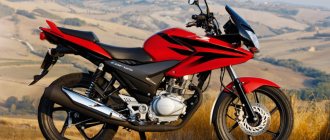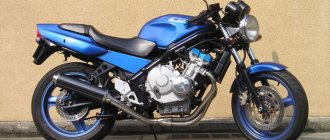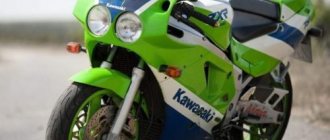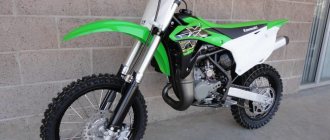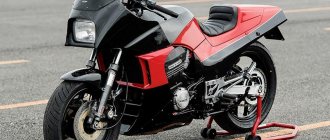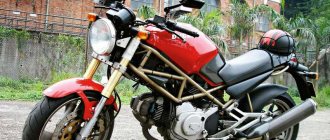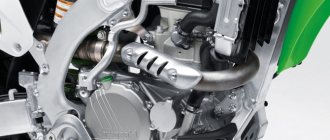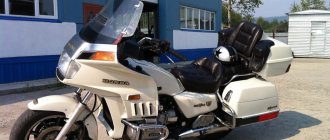- motorcycle model, Honda brand,
The Honda SLR 650 enduro motorcycle model was produced from 1996 to 2000. Initially, the model positioned itself as a city motorcycle with the ability to travel on light off-road and dirt roads. In its appearance, the Honda SLR 650 is more similar to a Scrambler - a class of motorcycles that precedes enduro and combines the qualities of both road and off-road motorcycles.
The main feature of the Honda SLR 650 is its 1-cylinder air-cooled engine with a capacity of 644 cc. see, producing from 34 to 39 hp. power and 51-54 Nm of torque. The engine is low-speed, showing maximum performance at 4500-5750. This motor was not an independent development, but was a rather archaic power unit installed on the Honda NX650 Dominator, Honda FMX 650, Honda XR 650 and Honda FX 650 Vigor models. Despite the weak dynamic characteristics and air cooling, the motor is extremely reliable and durable.
Appearance
Honda SLR 650 has a simple design. In the original color, this is a bike with a yellow frame and fenders. The exhaust pipe is partly chrome plated. The mirrors are round and located high. The insides of this motorcycle are quite visible. However, taking into account the class and design, this can hardly be regarded as a significant plus or minus.
The motorcycle is rather utilitarian, so it would be wrong to expect aesthetic beauty from it. No, he looks good in photos and even in videos. However, this cannot be compared with the beauty that a sportbike or cross-country motorcycle can please. But the bike has some kind of unobtrusive charisma.
Comfort
A motorcycle is comfortable if the person himself is not particularly large, and if the passenger is not heavy. Fuel consumption is average, but it won't break your pocket or force you to constantly fill up, given the size of the tank. If you do not accelerate to high speeds, the driving dynamics will not cause any inconvenience.
Yes, this copy is, in principle, not intended for high-speed racing. You shouldn't play around with such a car somewhere on a race track. The seating position is comfortable, as is the view through the mirrors. Maintenance is sometimes a problem because parts are hard to find.
Dimensions and weight
In terms of dimensions, this is an average car, although the tank volume is decent for this class. Those who often have to drive on bad roads will appreciate the high ground clearance. This significantly reduces the risk of damage to the motorcycle. Not to say that the height is large, but certainly not small. This characteristic also applies to other parameters.
Dimensions:
- tank – 13.4 l;
- ground clearance - 197 mm;
- curb weight – 175 kg;
- height – 1144 mm;
- width – 765 mm;
- length – 2182 mm;
- seat height – 840 mm.
The curb weight of this bike is significant. Without the appropriate muscles, it will be difficult to move it with your hands if you run out of fuel. Even just driving or standing in a traffic jam will be difficult. However, if this is not the first motorcycle for a person, then it is unlikely that there will be problems with it. But people of fragile build should take a closer look at even more compact and lightweight bikes.
Hello everyone, Happy 2021, this is my second post here. The first one (2016) was about my first Soviet motorcycles, and this one will consist of three parts: choosing, purchasing and transporting a used Japanese motorcycle.
I’m not going to give a lot of advice, mostly this is the personal experience of a teapot who has never sat on a “Japanese” and decided to buy one.
My last motorcycle from the Soviet era is the Dnepr MT 10-36 from 1982. Here is his photo.
In my opinion, a motorcycle should not sit in a garage, but should carry its owner, i.e. me and preferably not around the city, but far away often and a lot. And for this, of course, it needs to be serviced: change consumables, tires, and other spare parts. And this is where the Dnieper has a hard time. It is not suitable for the role of an everyday moto, it can be used for long-distance driving, but again, after every not very long trip I had to disassemble the engine, or even repair it on the road. After a couple of seasons, I finally realized that I needed another motorcycle: one for which I can easily buy high-quality spare parts (even if expensive), one that is not afraid of long-distance driving, and in general, one that can ride, ride, and not break down.
Here we come to the first part:
1. Part one: Choosing a used Japanese car. Everyone has their own tastes and needs, I will speak for myself. I don’t like: choppers (purely appearance), cruisers (the same, but smaller), sports (landing position and shrill engine), crosses (appearance). Besides these reasons, all these categories are not suitable for their intended purpose: you need a motorcycle that feels equally good on the road and off-road, without high speeds, beautiful (for me :)), not very heavy (around 160 - 220 kg), with the availability of spare parts and repair possibilities (and therefore common), not too expensive. In short, I like road bikes and enduro (tourenduro), what can I do? The first thing I noticed was the Yamaha YBR 125. The advantages are obvious: a lot of spare parts, reliable, long-range, only the cruiser let us down: 85-90 km. In addition, I wanted to get a new one with a guarantee from an off-site dealer. At that time it cost about 90 - 95 thousand rubles, which was affordable. I looked at a salon with Ebras, but then a crisis arrived (an increase in the dollar) and the price smoothly exceeded a hundred and climbed further. As a result, a new EBR began to cost more than a used one, 400-600 or even 800 cc motors. Yamaha YBR 125
I immediately switched to them: even if they weren’t new, they were 400, or even 600 cubic meters! This is already much steeper and the cruiser can be kept at 110-120. Somehow it turned out that after Ebra I began to dream of a Transalpa 600. A well-known motorcycle, beautiful, reliable, spare parts available for now, not afraid of off-road conditions, long-distance driving is his element, and not particularly heavy. Finding a 600 in good condition inexpensively is quite difficult, and I assumed that I could settle for the Transalp 400. A little less horses, with spare parts that seem to be worse, otherwise the same 600. Having caught fire with Transalp, at the end of February I almost took out a loan for the purchase, but two banks refused and it was luck, because I would have had to pay 1.5 times more! I would have missed the season, because even consumables would not have been affordable. To broaden my horizons about these moths and in order to communicate with the owners, I joined the Transalpovodov club and I think I did the right thing. The people there were serious, willing to answer questions, and in general I liked the club’s website, everything was done wisely. Everyone is accepted, no matter what equipment you have or whether you have any money at all :). I recommend it to anyone who wants to adequately communicate on any topic and, of course, motorcycle topics. Photos of TA400 and TA600 '87 and '99.
This is already much steeper and the cruiser can be kept at 110-120. Somehow it turned out that after Ebra I began to dream of a Transalpa 600. A well-known motorcycle, beautiful, reliable, spare parts available for now, not afraid of off-road conditions, long-distance driving is his element, and not particularly heavy. Finding a 600 in good condition inexpensively is quite difficult, and I assumed that I could settle for the Transalp 400. A little less horses, with spare parts that seem to be worse, otherwise the same 600. Having caught fire with Transalp, at the end of February I almost took out a loan for the purchase, but two banks refused and it was luck, because I would have had to pay 1.5 times more! I would have missed the season, because even consumables would not have been affordable. To broaden my horizons about these moths and in order to communicate with the owners, I joined the Transalpovodov club and I think I did the right thing. The people there were serious, willing to answer questions, and in general I liked the club’s website, everything was done wisely. Everyone is accepted, no matter what equipment you have or whether you have any money at all :). I recommend it to anyone who wants to adequately communicate on any topic and, of course, motorcycle topics. Photos of TA400 and TA600 '87 and '99.
In the process of saving up money for Transalpa, I learned more and more about it and about Japanese spendthrifts in general. Other options began to pop up: I was sick with C-Bihoy (common, reliable, a lot of gas), I didn’t like the revved-up engine and it wasn’t very good off-road. Long distance is quite possible. She is also short for me (height 182 cm). Photo by CBC.
Then it was time for checks. And what? Even if there are few horses, it is light, has a simple engine, is capable of off-roading and long-distance driving. I especially liked the Yamaha TTR Raid. Yes, the cruiser is low 95-100 km, but higher than that of Ebrik. The tank is small, but the consumption is also low. Another minus of the checks is the low service mileage (every 1500 oil changes), because The engine is relatively weak and air cooled. Fans of “chekushki” find themselves in the Jebel Club to learn more about them, register there too. There, people agree that Jebel is the best among the “checks,” with Yamaha TTR and Honda Baja in second place. But I liked the TTR, and it suits my height (check the saddle height for you!). I also looked at the Honda AX, a rather rare beast - 250 cc with dropsy. I also suffered from “checks.” Photo of Honda XR 250 BAJA, Suzuki Djebel 250, Yamaha TTR 250 Raid, Honda AX-1 (NX 250).
Or maybe there is something with a simple single-cylinder engine, enduronic, water-cooled and 600cc? It turned out there is, of course! When I saw the Yamaha XTZ 660 Tenere, I immediately fell in love with it. Slender, lean, with a minimum of plastic, unlike Transalp, large tank, one cylinder, one spark plug, one carburetor, water cooling, decent power, saddle height for my height! (Transalp has 4 spark plugs, two carburetors; after the Dnieper, such difficulties caused concern). Of course, there are drawbacks: there have been reviews that the 5-valve engine eats oil; in long-distance driving you will get vibrations from the low-speed single-cylinder engine. But outwardly he looks almost perfect to me. I immediately register in the Shadow Guides club :). Photo of Tener 1st and 2nd generations (with dropsy).
Transalp began to fade into the background. By inertia, I still monitored prices and offers, but as a backup option. In first place was Tenera. Of course, all my throwing was reflected on the Transalp Club forums. And they really bothered the people living there :). Along the way, I examined the BMW F650, I can only say that the Germans are a little more expensive. Photo of BMW F650.
And also the Suzuki DR 650 RS (Suzuki DR650SE is still in production!). They warned me on the forum about the features of the engine of different editions, I won’t tell you the details because I didn’t quite understand (something about 1996).
And the Honda NX 650 Dominator, they said that it’s not for everyone, but overall it’s good.
The end of summer (season) has come, the time to buy a motorcycle for those who like to do everything right. (There is also an opinion that you should buy in the middle of the season). I have been actively selling Dnepr since July, but without much success, there were calls, but nothing serious. At the end of August, I discovered several suitable offers from Tenera in Moscow and other regions and began preliminary calls and correspondence by email. Of course, my illness and activity by the end of the summer did not pass by my wife. Having attended one such conversation, she realized that I seriously wanted to pay 150-200 thousand for a motorcycle. (When I started messing with the Dnieper, she was categorically against it). A “concrete” conversation took place, but I was unshakable :). Then a condition was put forward: the motorcycle being purchased should not require repairs, even if it is more expensive, but in good or excellent condition. And of course, don’t rush, yours will not leave you, etc. and so on. Meanwhile, negotiations with sellers went on as usual and now I have two options in Moscow, plus my wife wanted me to visit a motorcycle dealership, because... I'm less likely to buy junk there. As a result, we went to Moscow for examinations together :) Luckily for me, one kind person from the Tenera Club agreed to help with the first examination. Although I looked through a bunch of guides on what to do and where to look during an inspection, this is all theory. There is nothing better than an experienced person who knows WHAT it should look like. But let's go in order. You will read about this trip and inspections in detail in the second part; I will only say that we inspected a motorcycle dealership and two Teneras. The first one had some problems, we liked the second one and we agreed to meet with the seller in three weeks. If he leaves, it’s not mine, I didn’t leave any money.
Two weeks passed, the seller and I corresponded regularly, he answered a bunch of questions that interested me, and one fine day he announced that the buyer had come, inspected it and showed me the money. In general, Tenera is sold. Well, then it wasn’t my spendthrift. To dispel the melancholy, I post on the Transalp Club forum about the trip and inspections, there is a heated discussion, a lot of advice. And then one of his teammates writes: Yurik, you’re fed up with your torment, so I found you a moneymaker, buy it and calm down. And he gives a link to the Mototravels website. I go to the website: Honda SLR650 is for sale, has been on sale for two months, the price is divine (a little lower than my Moscow Teners), but somehow there are no hunters. I have never heard or read about such a model anywhere. At the club they say: this is the Dominator naked. I read more about her.
It turns out that Honda at one time made competition for Tenere: the same single-cylinder 650 cc engine, air-cooled, as on the first Tenere, was called the Dominator NX650. Then, based on it, they made the SLR650, the engine was the same, the appearance was slightly redesigned, the front wheel was 19 inches instead of 21, like a universal city motorcycle with the ability to go off-road (there was also a Vigor FMX 650 with the same engine). The Dominator’s star, like Tenera’s, was already setting, but the SLR didn’t save the situation either; the production ended two years later. That is, the motorcycle is rare, but the engine powered by the Dominator is quite common. Compared to Tenera and Transalp, there is no plastic at all, the tank is small, rugged, but generally suitable. This was the first impression. I contacted the owner, we talked normally, there were no other options at that time (Transalp only appeared for sale, but it was in Belarus and there were problems with the engine). When asked whether he would get to Magadan (this was the ultimate dream of mine, well, even going to Vladik on vacation), the firm answer was: yes, anywhere! This answer led to my decision: I’m going for an inspection (near St. Petersburg) and going with the money. Just at work they gave me a day off and it turned out to be three days off - straight from one to the other. This is where my torment of choice ended, now it’s in my garage: Honda SLR650 1996. (according to VIN 1997). Photo of my SLR650.
Let me summarize the history of the choice a little. There are no perfect motorcycles in the world. Each is a compromise between speed, power, price, cross-country ability, convenience when traveling long and short distances, the complexity of repairs and the availability of spare parts and services. Ideally, wealthy people buy two or even three motorcycles for different purposes. My goals were: inexpensive, unpretentious, with a cruise range of 100-110 km and the ability to travel long distances to any terrain (swamps do not count) and on any roads. Of course, the SLR650 has drawbacks, some of which I would even say are critical. For example, a small tank (only 10 l before reserve, Tenera: 23 l, Ebrik with a flow rate of 3 l: 12 l), lack of a developed plastic fairing (minus for comfort on the highway), air cooling (oil change every 3000 km, Transalp: 8-10 thousand km), derated engine (34 hp) developed in the early 80s, no central stand, branded luggage frames and protective arches, dry sump (not for everyone). But all these disadvantages can be overcome if desired: for a long-distance trip - take a 10 liter canister with you, we’ll put a windshield, air cooling - this way you don’t need a radiator and a pump and the engine is simpler, reduced power - longer life, we’ll make frames and arches, etc.
During the entire search, the following options were considered (produced before 2000):
1) Yamaha YBR 125 (new) 2) Honda XR 250 BAJA 3) Suzuki Djebel 250 4) Yamaha TTR 250 Raid 5) Honda AX-1 (NX 250) 6) Honda CB400 7) Honda XL 400 V Transalp Honda XL 600 V Transalp 9) BMW F650 10) Suzuki DR 650 RS 11) Honda NX 650 Dominator 12) Yamaha XTZ 660
V Transalp 9) BMW F650 10) Suzuki DR 650 RS 11) Honda NX 650 Dominator 12) Yamaha XTZ 660
Overall, I am pleased with the purchase, the first season and all the joys associated with it are ahead. Read about the inspection and purchase in the second part, about the transfer - in the third.
Specifications
In terms of filling, this is, of course, not a beast, but it’s not an entry-level model either. So, if you need a bike for all occasions, you should think about this option. Perhaps, this equipment is not suitable for long trips to other countries, but it is quite suitable for the role of a motorcycle for work and for tourism in the region.
| Rear brakes | one disc, 220 mm |
| Front brakes | one disc, 276 mm |
| Rear suspension | pendulum, 170 mm |
| Front suspension | telescopic fork, 190 mm |
| Overclocking | in 5.5 s to 100 km/h |
| Speed limit | 148 km/h |
| Torque at the limit | 54 Nm |
| Power to the limit | 39 hp |
| Steps in a box | five |
| Drive type | chain |
| Fuel consumption | 5.5 l per 100 km |
Such parameters, among other things, make the car economical. And this is important for a bike that a person uses every day. At the end of the month, when it comes time to calculate the expenses, he will be pleasantly surprised, especially if he used to ride a cruiser for many years. However, there are also more economical bikes.
Review of the Honda SLR650 motorcycle
I skated the 2010 season, during which time I installed a small windshield, a central case, a Starline signaling system, heated steering grips, changed the oil + filter once (240 RUR), an air filter (1150 RUR), and adjusted the timing gaps. At the end of the season the rear cylinder ran out, so I installed Michelin Sirac. I was very surprised when changing the oil: there was 3.75 liters in the system instead of the required 2.15 liters; when I went to the service center where the previous oil change was done, they knew nothing about dry sump engines.
Now I’ll tell you about the driving characteristics: the vibration is of course strong, a second balancer shaft would not have hurt the motor, but strangely enough, I was able to get used to it and now I don’t pay attention to the shaking. The maximum speed according to the passport, 150 km/h, is easily reached and always, whether uphill or downhill. The maximum I saw on the speedometer was 170.
Comfortable speed up to 140 km/h - the dynamics are still there and the motor does not shake and is controlled normally. The brakes are not weak, i.e. I can’t say anything negative about them - there’s enough. I brake with both, first a little with the rear, then with the front. The seat is hard, when driving for more than 2 hours the butt starts to ache, small smoke breaks help.
The bike runs great on dry forest roads, there’s enough suspension, but I don’t try too hard. In deep sand (as well as on clay) it already becomes heavy, due to the weight (174 kg loaded) and the high center of gravity. The fork is moderately soft, pleasant on bumps, but the rear shock absorber is harsh, adjusting the spring preload did not particularly improve the situation.
Riding with light and compact (the saddle is not very long) passengers does not cause discomfort. Large passengers push the driver onto the tank; it’s so uncomfortable to ride.
Gasoline was initially flowing at 95, then switched to 92, the compression ratio allowed, I didn’t notice any difference. Consumption is 5 liters on the highway and about 6 liters on the dirt road in 1st-2nd gears. If in the city you start at traffic lights “with all your money,” then the consumption can be increased to 10 liters. Tank 13l, reserve 1.5l.
The large single-barreled gun (I thought it was the biggest, but it turns out there is also a DR800 souza) is very distinctive and requires a certain skill for smooth movement. On the first two gears, the engine braking was very strong, the bike bit, at first I squeezed the clutch, but now I got used to it. Locomotive traction from the bottom, nice. But if you relax and forget to shift down, you get detonation instead of acceleration. Just don’t get impudent, the motor forgives the incorrectly selected gear for one gear, excuse me for two... It doesn’t go at all at the top, it’s unusual at first, instead of spinning up to the cutoff, it’s better to switch to the next gear. The exhaust sound, even from standard silencers, is very pleasant (there is a video on YouTube of an FMX650 with Remus forward flow). There is a kit for converting the engine to 700cc.
The gearbox (5speed) is clear, short-throw, neutral is caught both while standing and on the move (the light always lights up correctly), there are no false neutrals or mismatches - in general, Honda.
The clutch is not tight, the hand does not get tired. The tachometer is missing, I'll install it. Of course, I would also like a fuel level indicator, but it is more difficult to implement. The motorcycle always starts easily: cold with enrichment, hot with a light boost. Power system - 1 carburetor. The headlight shines perfectly, the standard lamp is a halogen 55/60W.
A motorcycle is rare for Russia; in Moscow I have not yet met owners of such equipment on the street. The following engines have the same engine: NX650 Dominator , SLR650 , FX650 Vigor , FMX650 (supermoto), XR650L - with varying degrees of boost. Of course, the reserves are not on the shelves in stores; you need to order through existential or other online stores.
I'm happy with the device, it can do a little bit of everything (city, highway, forest). For traveling nearby, this is what you need.
The SLR-650 is a good motor, no quality problems were noticed over 2 intensive seasons. The Dominator engine is derated to 38.5 hp (data from the MOTO magazine), from low speeds it rips like a scalded one, there is no top end. On the highway it dies at 140 (as does the XT600E). The suspension travel is also reduced, on the front fork that - about 180 mm. The gas tank is tiny - about 13 liters.
Go to the Honda SLR650
What do the owners say?
Many reviews of this model note that driving up to 140 km/h is comfortable. If the passenger is small in size, then it is comfortable to sit on and control the motorcycle. It is noted that the primer consumption can reach up to 6 liters. The suspension does not cause any particular enthusiasm, nor any complaints. It is clear that this is a simple, unpretentious option, but it gets the job done.
One review says that after a couple of intensive seasons there were not a single problem indicating poor quality. This is confirmed by the descriptions of their experiences by many other bikers. So it's safe to say that this bike is good. The main thing is to understand that its disadvantages are largely due to the price. About 155 thousand Russian rubles - that’s how much such a bike costs on the secondary market.
IMPORTANT! It is worth noting that this car is a rarity for Russia. It’s not so easy to buy a used copy, even in Moscow. On the one hand, this is a minus. But on the other hand, if you still manage to get such a model, it means that later it will probably be profitable to sell it. Firstly, this will be one of the few offers in the region, if not the only one, and secondly, this bike itself is a rarity. So the higher price will be justified.
It is noted that this is a good machine for those who have already had experience with both off-road bikes like enduro and road motorcycles. Especially if you no longer want extreme sports, and, on the contrary, a person needs a calm, measured ride, sometimes over rough terrain.
The SLR 650 is a rare motorcycle of far from the most popular class. The maximum speed, as well as acceleration to 100, is unlikely to impress anyone here. However, for those who simply need a recreational bike for the track and light off-road, the machine is optimal. At least if a person is not ready to pay a lot of money for a motorcycle.
Review of the Honda SLR 650 motorcycle
I skated the 2010 season, during which time I installed a small windshield, a central case, a Starline signaling system, heated steering grips, changed the oil + filter once (240 RUR), an air filter (1150 RUR), and adjusted the timing gaps. At the end of the season the rear cylinder ran out, so I installed Michelin Sirac. I was very surprised when changing the oil: there was 3.75 liters in the system instead of the required 2.15 liters; when I went to the service center where the previous oil change was done, they knew nothing about dry sump engines.
Now I’ll tell you about the driving characteristics: the vibration is of course strong, a second balancer shaft would not have hurt the motor, but strangely enough, I was able to get used to it and now I don’t pay attention to the shaking. The maximum speed according to the passport, 150 km/h, is easily reached and always, whether uphill or downhill. The maximum I saw on the speedometer was 170.
Comfortable speed up to 140 km/h - the dynamics are still there and the motor does not shake and is controlled normally. The brakes are not weak, i.e. I can’t say anything negative about them - there’s enough. I brake with both, first a little with the rear, then with the front. The seat is hard, when driving for more than 2 hours the butt starts to ache, small smoke breaks help.
The bike runs great on dry forest roads, there’s enough suspension, but I don’t try too hard. In deep sand (as well as on clay) it already becomes heavy, due to the weight (174 kg loaded) and the high center of gravity. The fork is moderately soft, pleasant on bumps, but the rear shock absorber is harsh, adjusting the spring preload did not particularly improve the situation.
Riding with light and compact (the saddle is not very long) passengers does not cause discomfort. Large passengers push the driver onto the tank; it’s so uncomfortable to ride.
Gasoline was initially flowing at 95, then switched to 92, the compression ratio allowed, I didn’t notice any difference. Consumption is 5 liters on the highway and about 6 liters on the dirt road in 1st-2nd gears. If in the city you start at traffic lights “with all your money,” then the consumption can be increased to 10 liters. Tank 13l, reserve 1.5l.
The large single-barreled gun (I thought it was the biggest, but it turns out there is also a DR800 souza) is very distinctive and requires a certain skill for smooth movement. On the first two gears, the engine braking was very strong, the bike bit, at first I squeezed the clutch, but now I got used to it. Locomotive traction from the bottom, nice. But if you relax and forget to shift down, you get detonation instead of acceleration. Just don’t get impudent, the motor forgives the incorrectly selected gear for one gear, excuse me for two... It doesn’t go at all at the top, it’s unusual at first, instead of spinning up to the cutoff, it’s better to switch to the next gear. The exhaust sound, even from standard silencers, is very pleasant (there is a video on YouTube of an FMX650 with Remus forward flow). There is a kit for converting the engine to 700cc.
The gearbox (5speed) is clear, short-throw, neutral is caught both while standing and on the move (the light always lights up correctly), there are no false neutrals or mismatches - in general, Honda.
The clutch is not tight, the hand does not get tired. The tachometer is missing, I'll install it. Of course, I would also like a fuel level indicator, but it is more difficult to implement. The motorcycle always starts easily: cold with enrichment, hot with a light boost. Power system - 1 carburetor. The headlight shines perfectly, the standard lamp is a halogen 55/60W.
A motorcycle is rare for Russia; in Moscow I have not yet met owners of such equipment on the street. The following engines have the same engine: NX650 Dominator, SLR650, FX650 Vigor, FMX650 (supermoto), XR650L - with varying degrees of boost. Of course, the reserves are not on the shelves in stores; you need to order through existential or other online stores.
I'm happy with the device, it can do a little bit of everything (city, highway, forest). For traveling nearby, this is what you need.
The SLR-650 is a good motor, no quality problems were noticed over 2 intensive seasons. The Dominator engine is derated to 38.5 hp (data from the MOTO magazine), from low speeds it rips like a scalded one, there is no top end. On the highway it dies at 140 (as does the XT600E). The suspension travel is also reduced, on the front fork that - about 180 mm. The gas tank is tiny - about 13 liters.


